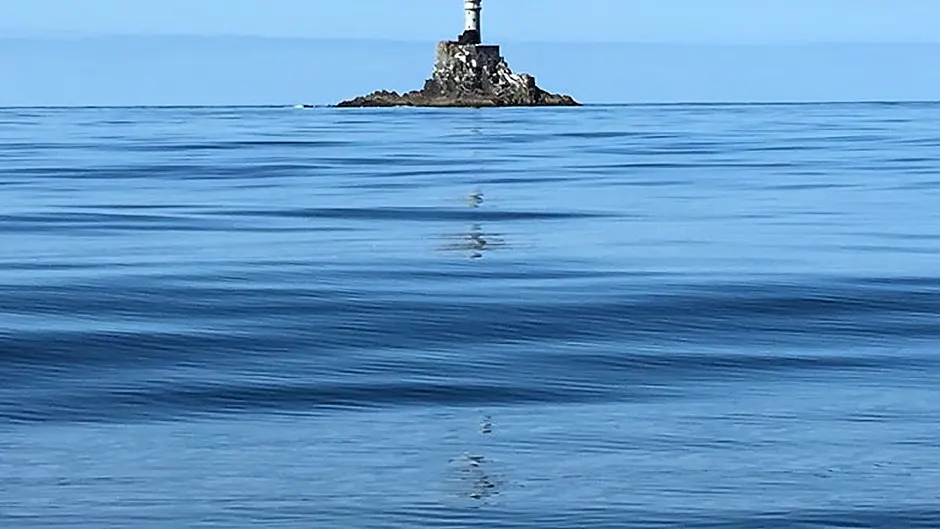Having had to abandon the 36km swim from Baltimore to the Fastnet – and back – after 11 hours last weekend, Steve Redmond isn't ready to give up yet
STEVE Redmond, who was the first person in the world to successfully complete the epic Ocean’s Seven Challenge – the swimming equivalent of conquering the highest mountains on each of the seven continents – is determined to succeed at his toughest challenge yet, a 36km swim from Baltimore to the iconic Fastnet Lighthouse and back.
People might think it has all been done before, but they would be wrong: people have swum from Baltimore to the Fastnet, and people have swum from the Fastnet to Baltimore, but no one has ever tried to swim both ways as part of a single challenge.
Having had to abandon his swim last weekend on the return journey from the Fastnet, after an incredible 11 hours in the water, Steve will enter the water in Baltimore once again over the coming weeks, and embark on a swim that could – using English Channel rules – take 14 hours or more to complete.
The real challenge in all of this, apart from the distance, is the timing. He will need to swim with the tide – six hours up and six hours down.
The timing will need to be precise because Steve will be facing into the vortex that all local mariners are familiar with, the Gaisceanan Sound.
It is the sound between Cape Clear and Sherkin Island and the tides there can be very strong. There are also a lot of over-falls, which is where one tide meets another, similar to what happens in an earthquake.
If Steve’s timing is out, he knows he will be in for one hell of a punishing swim because, as he says himself, ‘there is a suck in there the size of a football pitch.’
As a challenge, he said it is up there with any one of the seven open channel swims, but by doing it he knows he can help a local organisation – the West Cork Underwater Search and Rescue group – which is dear to his heart, as well as promote the Fastnet as ‘an international swim.’
‘This will be hugely difficult,’ said Steve, who has spent over three months following a gruelling training regime. ‘If you look up at all on the crossing, you can see the Fastnet but it is always in the distance. It never seems to get nearer. This has never been done before and that’s probably because it is so difficult.’
Steve is like a cat on a hot griddle. Even talking about it makes him a bit edgy. And he will probably continue to be like that until the deed is done.
‘Your affirmation has to be: it is going to be done,’ said Steve. ‘It’s all very Yoda: “Do or do not, there is no try”. You are going out there and you are not coming back until it is done.’
That is where the support team – the guys on the boat – come in. Steve said: ‘They won’t let you stop. It is their job to keep you going no matter what.’
Steve admitted that in some of his more hellish moments in the water he has begged to be let back on to the boat, including on a crossing of the English Channel, but his wife told the skipper to ‘throttle on.’ And, in New Zealand, the skipper threatened to drive the boat over his head if he didn’t continue.
‘There I was, begging to be let in but they know if they let you out it’s worse because it is the not finishing that hurts so much.’
To somebody who cannot comprehend this level of pain, or indeed this level of tough love, Steve shrugs and says: ‘Swimmers moan.’ And it is by completing the task that they develop what he calls the ‘change your life attitude.’
Steve talks about heading to Lough Hyne at 5.50am when there is no one else there. ‘It is like meeting the Lord,’ he said, ‘and you come back cleansed.’
His intensive solo training schedule involves swimming 30km to 40km a week, including a four, or five, hour swim once a week. But he won’t be on his own: his friends will be in the boat to cheer him on, or dispense tough love, whichever is required.
Steve is doing this as a personal challenge but also as a way to raise funds for the West Cork Underwater Search and Rescue group, which was formed following the Tit Bonhomme tragedy in Union Hall, and is currently in need of funds for equipment to carry out its potentially life-saving work.
The people who set it up are the people who helped Steve with his training and seven channel swims, so this, he said ‘is pay back.’
For the past three months, he has been putting himself through a horrendous training regime. His diet – the need to properly load up before every big swim – is also something to be endured.
Before each distance swim he has to take in 4,500 calories. He said: ‘I carb load the night before with a huge meal of pasta, and breakfast is a big bowl of porridge, plus three fluid feeds, which includes carbohydrates and amino acids, a cup of coffee and a Milky Way.’ And, if that wasn’t enough, he also has to be sure to consume two litres of water.
‘It’s not nice,’ he said, ‘but if your energy levels go down on a swim you are never going to get back. That’s the problem of swimming on your own.’
Steve grins and says that for good measure he also brings two or three gel packs – fluid carbs, like medicine – stuffed down his trunks because they are like battery packs and will give him another 30, maybe 40, minutes if his energy levels run low.
In his next attempt, he won’t have to worry about any of that because his 16-year-old daughter Siadbh will be on board and will be his feeder for the day – all of which is part of the English Channel rules.
The other rules specify that the swimmer must only be equipped with swimming togs and body grease; that the swimmer must never touch the boat; and that the event is only finished when he crawls up on the shore at the end of the challenge.
As part of the West Cork Underwater Search and Rescue group’s fundraising drive, people can donate through their Facebook page, or by signing one of sponsorship cards that are in circulation. There is even a prize for guessing the time it will take Steve to complete the swim.
When asked, Steve doesn’t hesitate. He says: ‘Put down 14 hours and 20 minutes.’










